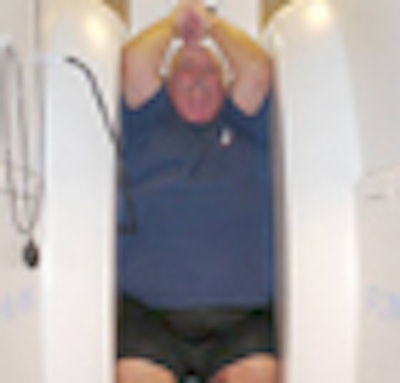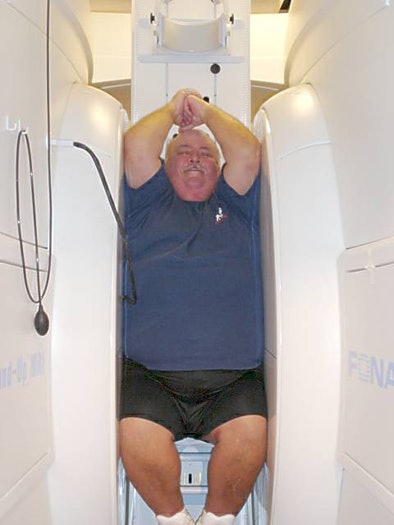
Outsized patients have a slim chance of getting scanned at most emergency departments in the U.S., according to a new survey in Obesity. Emergent care facilities simply don't have the equipment. And although some veterinary schools and zoos are equipped with large CT scanners, most have policies prohibiting the imaging of humans.
"Emergency departments (EDs) are frequently the site for acute care of obese patients," wrote study authors Dr. Adit Ginde, Dr. Anthony Foianini, Dr. Carlos Camargo, and colleagues from the University of Colorado Denver School of Medicine in Aurora, CO, and Harvard School of Medicine in Boston. "The ability to rapidly obtain cross-sectional imaging studies such as computed tomography (CT) and magnetic resonance imaging (MRI) is essential to diagnose and treat many of these patients" (Obesity, September 11, 2008).
Unfortunately, the demand far exceeds the supply of emergent care facilities capable of treating obese patients, the authors wrote. "Typically, CT and MRI equipment have table weight limits of 350-450 lb to avoid equipment damage, and are additionally limited by gantry and bore diameter," they wrote. "Although large weight capacity equipment is manufactured, their availability for emergent imaging studies is unknown."
Ginde and his team surveyed radiologic technologists across the U.S. to assess the availability of large-capacity scanners capable of imaging patients weighing 450 lb and more.
Using the 2005 National Emergency Department Inventories as a guide, the researchers telephoned a random sample (n = 262) amounting to 5% of all U.S. hospitals with emergency departments. Hospitals were further characterized as trauma centers, primary stroke centers, and bariatric surgery centers of excellence, based on data from the American College of Surgeons.
They also interviewed technologists at 136 hospitals affiliated with U.S. academic centers and medical personnel at 145 zoos and 28 private veterinary care facilities. When referred by the technologists, their supervisors or physician assistants in the department were also interviewed. In the case of animal care facilities, veterinarians provided the information.
The response rate was generally high. The study investigators collected data from 260 hospitals (99%), 136 academic hospitals (100%), 138 zoos (94%), and 28 veterinary schools (100%). And there was high interobserver agreement for weight capacity (k = 0.89 for CT and 0.79 for MRI).
 |
| Presurgical 425-lb patient is scanned on a Multiposition Open MRI scanner equipped with a planar coil. Larger patients may be turned sideways and scanned using a solenoidal belt coil. Image courtesy of Fonar. |
The researchers found that more academic hospitals (28%) had large weight capacity CT equipment (> 450 lb limit) compared to the national sample overall (10%, p < 0.001). On the other hand, large-capacity MRI scanners were scarce in both academic centers (10%) and nationwide (8%).
Surprisingly, even facilities that marketed their services specifically to obese patients as "bariatric surgery centers of excellence" were rarely equipped with large-capacity CT scanners: just 21% of the bariatric centers surveyed were equipped for large patients.
"This is of particular concern, given that the number of gastric bypass surgeries performed in the U.S. has increased from 67,000 in 2002 to 140,000 in 2005, and that up to one-third of patients undergoing gastric bypass surgery will require an ED visit in the postoperative period," the group wrote. "Accordingly, some surgeons may not even perform the operation for patients that exceed equipment weight capacity."
CT scanners
|
Above and below tables present weight limits and gantry aperture information for scanners from major manufacturers; information derived from AuntMinnie.com's Buyer's Guide.
MRI scanners
|
As for animal care facilities, only two of the zoos had large-animal CT scanners, and both of these said they wouldn't image human patients. More than half of veterinary schools had large-animal CT scanners with a 2,000-lb weight capacity, but only four of these institutions (14%) said they would consider imaging human patients. In fact, most of the veterinary schools surveyed (n = 23, 92%) said they had formal policies prohibiting the scanning of human patients.
"In this study, we found that limited access to large weight capacity equipment in U.S. hospital-based EDs (CT 10%, MRI 8%) further limits the quality of acute care for some obese patients," the authors wrote. "Indeed, CT or MRI imaging was required for 11.2% of all U.S. ED visits in 2005, and is the standard of care of ED evaluation for many acute medical conditions, including trauma, acute abdominal pain, pulmonary embolism, and stroke."
In academic emergency departments, the use of CT is even higher, performed in 39% to 70% of ED visits, they wrote. And the need for larger-capacity scanners is growing. Between 1988 and 1994 there were 470,000 adults in the U.S. weighing more than 350 lb. By 1999-2004 the number had grown to more than 600,000.
"Our data suggest that one-quarter of all U.S. EDs would not be able to obtain CT imaging for patients > 350 lb, and two-thirds would not be able to obtain MRI studies," Ginde and his team wrote. "Further, almost all EDs (at least 90%) would not be able to obtain CT or MRI imaging studies for patients > 450 lb."
In rural areas access to large weight capacity scanners is even more limited, even in designated critical care hospitals.
For some obese patients, especially those weighing more than 450 lb, access to urgent-care CT and MRI is limited, even at academic and bariatric surgery centers, the authors wrote.
Animal facilities are not a viable alternative for diagnostic imaging of human patients, the authors concluded. The limited capacity to obtain diagnostic imaging due to equipment weight limitations "may significantly limit the ability to deliver quality emergency care for an important segment of the U.S. population," they wrote.
By Eric Barnes
AuntMinnie.com staff writer
September 24, 2008
Related Reading
Obesity associated with more healthcare usage during pregnancy, April 3, 2008
Obese patients challenge efficacy of cardiac CTA, March 11, 2008
Rampant U.S. obesity strains imaging devices, November 28, 2007
Obesity increases radiation dose delivered during atrial fibrillation ablation, July 20, 2007
Obesity forces radiology to supersize, enhance x-ray technology, March 1, 2007
Copyright © 2008 AuntMinnie.com



















